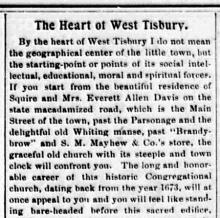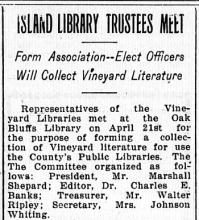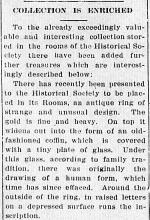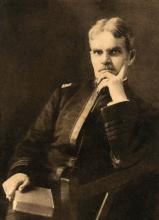A new fireproof building to house the priceless records and collections of the Dukes County Historical Society is to be built on the land on School street, Edgartown, adjoining the grounds of the society’s Squire Cooke house. The new structure, although placed near School street on this lot, will face toward Cooke street, making an angle with the Gay Head lens tower and the Cooke house.
Theodore P. Henley of Edgartown, who will be the contractor, has drawn the plans for the building which will, in effect, reproduce the former Olsen cottage, now owned by Mrs. Watson Cobb, which stands on the opposite side of School street. This is a lovely story and a half cottage of an old Vineyard type.
Concrete blocks will be used for the fireproof construction, painted white to fit the Edgartown surroundings. Provision will be made for a future addition toward the rear of the lot when and if circumstances warrant, according to Gerald Chittenden, president of the society.
An Ambition of Years
Meantime the society will have an exhibition room and stack and storage room for irreplaceable materials, carrying out an ambition of many years. The basement will be fully excavated and will be sufficiently lighted to be used for working space.
When the Cooke house was first acquired, criticism was directed at it by the late Dr. Charles E. Banks and others on the ground of fire risk. At first the hope to providing some fireproof accommodations seemed a dim one, then, following the bequest of Mrs. Edward D. Thayer, it seemed to be possible of accomplishment. A few years ago the added land on School street was acquired for the purpose.

From the May 28, 1954 edition of the Vineyard Gazette:
D.C.H.S. New Museum Is Officially opened
Between seventy-five and eighty persons were present on Tuesday for the official opening of the new museum building at the Dukes County Historical Society headquarters in Edgartown. This group included local membership and delegations from some seven Cape Cod historical societies, the occasion representing a gathering of the Council of Cape and Island Historical Societies.
The organization took over the meeting after preliminary remarks by Gerald Chittenden, president of the Dukes County Historical Society, and Richard B. Jackson, president of the council, presided. Routine business and reports were handled and the same panel of officers was re-elected, plus the addition of two directors at large, Mr. Chittenden, and Mrs. Walter Adams of Nantucket, who was not present.
New business included the proposal to enter into the effort to record on tape and eventually upon disc records, folk takes of the Cape and islands as told by local characters. Something of the kind has been done in a small way, it was explained, but the task is large and the cooperation of the various historical societies is required if a satisfactory job is to be performed.
Lose Charm in Print
As it was represented, such folk tales lose something of their charm when they appear in print, but recorded in the actual tones and inflections of the “older inhabitants” if any place, they constitute an interesting and delightful memorial to natural story-tellers as well as preserving stories which may well possess historical value and significance.
Everyone admired the new building, a structure twenty-five by thirty feet, with a full basement, constructed by Theodore P. Henley, Edgartown contractor. The walls are of cement blocks, waterproofed, and the white interior, including the shelving, is unusually attractive. Within and without, the building smacks of the Cape Cod style of architecture which is the Vineyard’s as well, the interior in particular possessing many of the traditional characteristics of the old fashioned parlor.
The building is designed to hold the valuable letters, books, and documents of the society, and the cases are well filled already with the valuable accumulation of years. The new structure, fireproof, appears to be most satisfactory for the purpose. Its use will also make more room in the society’s house, the old Squire Cooke home, for exhibitions of historical material.
Mrs. B. C. Mayhew of Chilmark, secretary of the society, and H. Franklin Norton, its curator, and Mrs. Norton are responsible for much of the success of the overall project. The society’s property now embraces a group of buildings, with the original house, the tower holding the Fresnel lens from Gay Head, the new museum, and a carriage shed at the rear of the lot to shelter boats and other large historical items. This shed also built by Mr. Henley, was designed by him more or less after the old church carriage shed that stood for years at North Tisbury.
Whole Setting Attractive
The whole setting of the group of buildings is attractive, and the design and detail of the new structures have been carefully adapted to the purpose for which they will be used.
The speaker of the day, Joseph Chase Allen, was introduced by Mr. Chittenden, and refreshments followed, served by a large committee of Island ladies.
The informal talk by Joseph Chase Allen of the Gazette staff consisted of a brief resume of the traditional background of the race of early seafarers, serving to show to some extent the influence of other races upon their culture. It was the speaker’s contention that no true picture of the Viking can be formed without acceptance of some portions of the tradition or folk-tale of these people, and also that certain conclusions arrived at by historians must be discarded.
He described the Viking as an undersized individual, heroic as to ambition but capable of accomplishing much by attacking his problems in large numbers. He suggested that he was not as proficient in the construction of stone buildings as his ancestors of some hundreds of years previous, and cast doubt upon Viking connection with the old stone tower at Newport because of its Roman arches.
He discredited the tales of sea-voyages in sixty-foot galleys because of the inability of such boats to carry sufficient food and water for the large crews necessary; twenty oarsmen, and an undetermined number of others. But describing galleys of 135 feet in length, with thirty oarsmen on each side, he said he thought that there is no reason why such ships could not have crossed the Atlantic carrying their crews, provisions and even the live animals which were carried to supply fresh meat. He believed that such galleys might have landed anywhere along this section of the coast and very probably did.
But, he said, the evidence that this is true, is entirely lacking. Referring to the drill-holes found in the rocks at Bass River, he said that a Viking mooring stone has holes clear through it, large enough to permit the passage of a man’s arm. He described other arms and equipment of Vikings to prove his point that they were small men.
In conclusion he retold the story of the death of Thorwald, brother of Lief Erikson, who was shot by an Indian arrow in the “new, Western land.” He connected this ancient tragedy with the Cromlech of Quitsa, and perhaps the only ancient monument of its kind in America. Though admittedly of a type of burial marker employed centuries before the Viking age, yet it was a thing with which the Vikings were thoroughly familiar and when, in their attempt to mark the grave in a distinctive manner, as the saga states, he surmised they may well have employed this means as being the best and most distinctive possible under the circumstances.
The appearance of certain “finds” differing from the Indian relics here on the Island, supports this idea, he said, although he admitted that the whole is fantastic. Yet, he said, no other explanation appears to coincide as well with the story as preserved in the tale of the ancient minstrels.











Comments